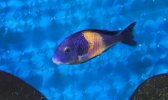Now that there are multiple Tropheus-keepers on this board, I've been thinking that perhaps we should have a little corner devoted to discussions of these interesting and challenging fishes. Everyone is welcome! So let's start with some background.
The type species of the genus, Tropheus moorii, was first described by Boulenger in 1898, but these fishes were largely unknown in the aquarium hobby until the mid-1970's. Since then Tropheus have become the most popular Tanganyikans in the hobby, and for good reason. Endemic to Lake Tanganyika, these highly specialized fishes inhabit rocky shallows that are distributed throughout the ~1200 mile shoreline of the lake. Because Tropheus populations tend to be isolated from their neighbors, they evolved independently, producing an array of more than 120 distinct populations that are known at present. The taxonomy of the genus is confused, and it is unlikely to be resolved anytime soon, as access to large areas of the shoreline (especially in the politically unstable Democratic Republic of the Congo) is impossible. My own view is that Tropheus can be divided into the four scientifically-recognized species- Tropheus moorii, T. annectens, T. duboisi, and T. brichardi- plus four proposed species- T. maculatus, T. sp. 'black,' T. sp. 'red,' and T. sp. 'mpimbwe.' In my opinion, the proposed T. polli, T. sp. 'kasabe,' and T. sp. 'ikola' are junior synonyms of described taxa, and thus invalid. I expect that additional species will be described once further research on these fishes, including DNA typing, has been completed.
Recently I have been re-reading two of the most informative books that have been published on Tropheus in the wild- Ad Konings' 'Tropheus in their Natural Habitat,' and Peter Schupke's 'Tropheus' in the Aqualog series. Here is an excerpt from Konings' book describing the collection point around Bemba (a. k. a. Pemba or Cape Munene), an area in the extreme northwest corned of the lake that was first explored by Pierre Brichard in the 1950's. It is home to a Tropheus population- Tropheus sp. 'black' Bemba- that has been popular with Tropheus hobbyists for many years-
Here is what Konings wrote about collecting Tropheus at Bemba-
'The so-called Bemba Moorii* is black with a very wide bright orange bar on the body. Juveniles are dark brown with a few gray-yellow bars on the flank. The underwater scenery at this locality is spectacular, with hundreds of little streams of air bubbles rising up from the bottom and with rocks made of lava that are overgrown with ruby-red algae and fluorescent green sponges.'
*This outdated trade name refers to Tropheus sp. 'black' Bemba.
The most up-to-date scientific publication that summarizes the taxonomic status of all known cichlid fishes of Lake Tanganyika can be found in-
Ronco, F., Büscher, H. H., Indermaur, A., and Salzburger, W. (2020) J. Great Lakes Res. 46(5):1067-1078.
https://europepmc.org/article/pmc/pmc7574848#free-full-text
More to follow...
The type species of the genus, Tropheus moorii, was first described by Boulenger in 1898, but these fishes were largely unknown in the aquarium hobby until the mid-1970's. Since then Tropheus have become the most popular Tanganyikans in the hobby, and for good reason. Endemic to Lake Tanganyika, these highly specialized fishes inhabit rocky shallows that are distributed throughout the ~1200 mile shoreline of the lake. Because Tropheus populations tend to be isolated from their neighbors, they evolved independently, producing an array of more than 120 distinct populations that are known at present. The taxonomy of the genus is confused, and it is unlikely to be resolved anytime soon, as access to large areas of the shoreline (especially in the politically unstable Democratic Republic of the Congo) is impossible. My own view is that Tropheus can be divided into the four scientifically-recognized species- Tropheus moorii, T. annectens, T. duboisi, and T. brichardi- plus four proposed species- T. maculatus, T. sp. 'black,' T. sp. 'red,' and T. sp. 'mpimbwe.' In my opinion, the proposed T. polli, T. sp. 'kasabe,' and T. sp. 'ikola' are junior synonyms of described taxa, and thus invalid. I expect that additional species will be described once further research on these fishes, including DNA typing, has been completed.
Recently I have been re-reading two of the most informative books that have been published on Tropheus in the wild- Ad Konings' 'Tropheus in their Natural Habitat,' and Peter Schupke's 'Tropheus' in the Aqualog series. Here is an excerpt from Konings' book describing the collection point around Bemba (a. k. a. Pemba or Cape Munene), an area in the extreme northwest corned of the lake that was first explored by Pierre Brichard in the 1950's. It is home to a Tropheus population- Tropheus sp. 'black' Bemba- that has been popular with Tropheus hobbyists for many years-
Here is what Konings wrote about collecting Tropheus at Bemba-
'The so-called Bemba Moorii* is black with a very wide bright orange bar on the body. Juveniles are dark brown with a few gray-yellow bars on the flank. The underwater scenery at this locality is spectacular, with hundreds of little streams of air bubbles rising up from the bottom and with rocks made of lava that are overgrown with ruby-red algae and fluorescent green sponges.'
*This outdated trade name refers to Tropheus sp. 'black' Bemba.
The most up-to-date scientific publication that summarizes the taxonomic status of all known cichlid fishes of Lake Tanganyika can be found in-
Ronco, F., Büscher, H. H., Indermaur, A., and Salzburger, W. (2020) J. Great Lakes Res. 46(5):1067-1078.
https://europepmc.org/article/pmc/pmc7574848#free-full-text
More to follow...
Last edited:


